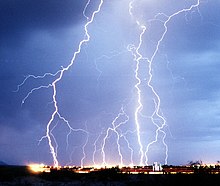| Lightning injury | |
|---|---|
| Other names | Effects of lightning |
 | |
| Multiple lightning bolts strike a populated area. | |
| Specialty | Emergency medicine |
| Types | Direct strikes, side splash, contact injury, ground current[1] |
| Causes | Lightning strike[1] |
| Diagnostic method | Based on history of the injury and examination[1] |
| Prevention | Avoiding the outdoors during a thunderstorm;[2] sheltering in a fully-enclosed structure;[3] if still outdoors, assuming 'lightning position' before a strike[3] |
| Treatment | CPR, artificial ventilation[1] |
| Frequency | 240,000 a year[1] |
| Deaths | 24,000 a year[1] |
Lightning injuries are injuries caused by a lightning strike.[4] Initial symptoms may include heart asystole and respiratory arrest.[1] While the asystole may spontaneously resolve fairly rapidly, the respiratory arrest is typically more prolonged.[1] Other symptoms may include burns and blunt injuries.[1] Of those who survive, about 75% have ongoing health problems as a result, such as cataracts and hearing loss.[1] If death occurs it is typically from either an abnormal heart rhythm or respiratory failure.[1]
Lightning injuries are divided into direct strikes, side splash, contact injury, and ground current.[1] Ground current occurs when the lightning strikes nearby and travels to the person through the ground.[1] Side splash makes up about a third of cases and occurs when lightning strikes nearby and jumps through the air to the person.[1] Contact injury occurs when the person is touching the object that is hit.[1] Direct strikes make up about 5% of injuries.[1] The mechanism of the injuries may include electrical injury, burns from heat, and mechanical trauma.[1] Diagnosis is typically based on history of the injury and examination.[1]
Prevention includes avoiding being outdoors during a thunderstorm, and sheltering in a fully enclosed structure (such a closed building or metal car).[2][5] If being outdoors is unavoidable, bringing the feet and knees together is recommended (if possible, while crouching low in the 'lightning position'— crouched low, hands over ears, feet touching if possible) so as to provide only one point of contact with the ground.[2][5] When indoors the use of devices connected to electrical outlets and contact with water is not recommended.[2] Among those who appear in cardiac arrest and have no central pulse, cardiopulmonary resuscitation (CPR) should be started.[1] In those who have a central pulse but are not breathing artificial ventilation, such as mouth to mouth, is recommended.[1][6]
As of 2019, it has been estimated that lightning injuries occur 240,000 times a year with 24,000 deaths.[1] Areas with mountainous terrain and moisture-heavy airflow, such as Central Africa, have the highest rates of lightning strikes.[3] Among pregnant women who are hit by lightning, the death of the fetus occurs in about half.[1] In the United States, about 1 in 10,000 people are hit by lightning during their lifetime.[1] Males are affected four times more often than females.[1] The age group most commonly affected is 20 to 45 years old.[1]
- ^ a b c d e f g h i j k l m n o p q r s t u v w x y Jensen JD, Vincent AL (January 2019). "Lightning Injuries". StatPearls. PMID 28722949.
- ^ a b c d "Lightning Safety Tips". CDC. 23 January 2019. Retrieved 11 November 2019.
- ^ a b c Cite error: The named reference
Davis2014was invoked but never defined (see the help page). - ^ Mallinson T (2013). "Understanding the correct assessment and management of lightning injuries". Journal of Paramedic Practice. 5 (4): 196–201. doi:10.12968/jpar.2013.5.4.196.
- ^ a b Cite error: The named reference
:2was invoked but never defined (see the help page). - ^ "First Aid Recommendations Lightning". CDC. 23 January 2019. Retrieved 11 November 2019.